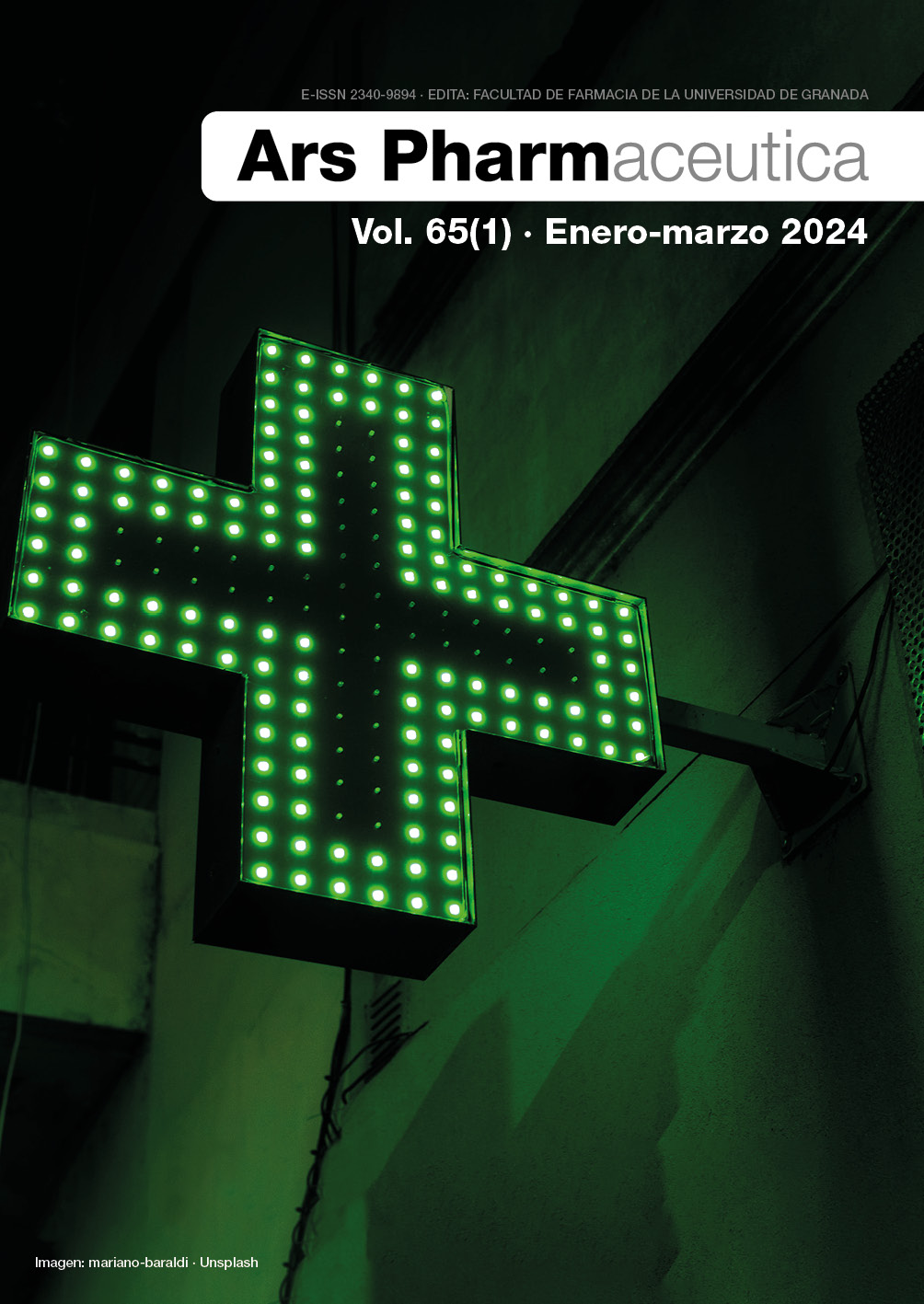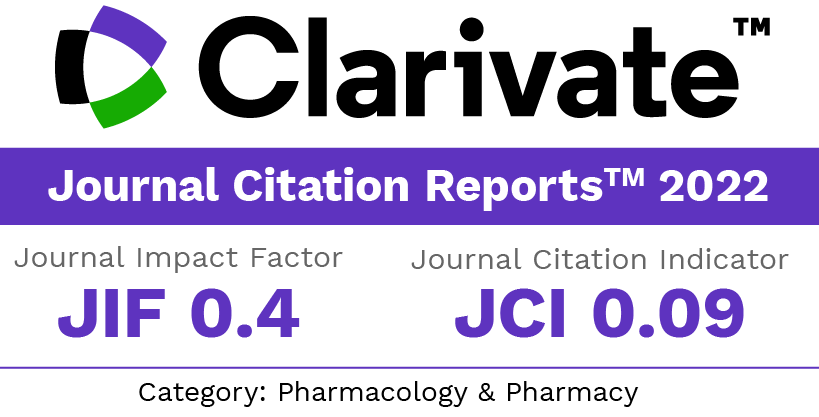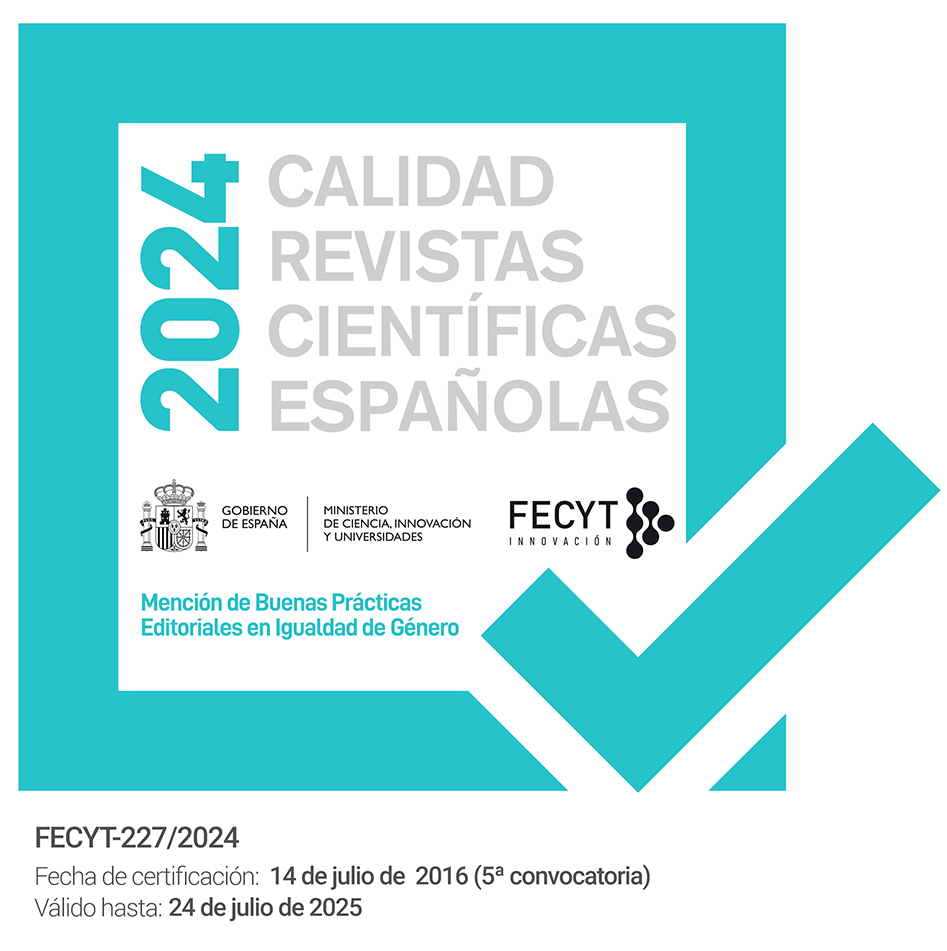Evaluación preclínica de la actividad antiinflamatoria de un gel con aceite de árbol de té
DOI:
https://doi.org/10.30827/ars.v65i1.29152Palabras clave:
Agente anti-inflamatorio, enfermedad periodontal, fitoterapia, aceite de árbol de té, evaluación preclínica de fármacosResumen
Objetivo: Evaluar la actividad antiinflamatoria de una formulación semisólida que contiene Aceite de Árbol de Té (AAT), a dos concentraciones (2 % y 2,5 %), para futuro tratamiento de enfermedad periodontal.
Método: Prueba preclínica de edema auricular por aceite de crotón, con una muestra de 30 ratones, para ser comparados con Indometacina y Diclofenaco.
Resultados: La concentración al 2 % mostró un 51,21 % de inhibición de la actividad inflamatoria, mientras que para la concentración del 2,5 %, fue de 54,74 %. Las pruebas estadísticas para conocer la eficacia de los tratamientos demostraron que no existen diferencias significativas entre las combinaciones de tratamientos, indicando que todos tratamientos son similares (p>0,05).
Conclusiones: Los resultados de este estudio demuestran que la forma semi solida de AAT, en los estudios preclínicos en la fase de ensayos in vivo con animales no humanos demostró poseer una actividad antiinflamatoria.
Descargas
Citas
Macín Cabrera SA. Tratamiento periodontal no quirúrgico en pacientes con gingivitis y periodontitis moderada: respuesta microbiológica y bioquímica [tesis doctoral]. Madrid: Universidad Complutense de Madrid; 2010.
Casarin M, Pazinatto J, Santos RCV, Zanatta FB. Melaleuca alternifolia and its application against dental plaque and periodontal diseases: A systematic review. Phytother Res. 2018; 32(2):230-242. DOI: 10.1002/ptr.5974
Kaur G, Grover V, Bhaskar N, Kaur RK, Jain A. Periodontal Infectogenomics. Inflamm Regen. 2018; 38(1):8. DOI: 10.1186/s41232-018-0065-x
Falcao Costa C, Moura E Sá A, Faria Almeida R, Bascones A. Antibioterapia en Periodoncia: Situación actual I- Antibióticos Sistémicos. Avances en Periodoncia e Implantología Oral. 2001; 13:39-47.
Regalado AI, Sánchez LM, Mancebo B. Actividad anti-inflamatoria de los extractos metanólicos de hojas y de tallos de Tabebuia hypoleuca (C. Wright) Urb. J Pharm Pharmacogn Res. 2015; 3(5):109-117.
Vivot EP, Sánchez C, Cacik F, Sequin C. Actividad antibacteriana en plantas medicinales de la flora de Entre Ríos (Argentina). Ciencia, Docencia y Tecnología. 2012; XXIII(45):165-185.
Hernández Rodríguez A. Fitoterapia. Bases científicas y legales para su aplicación. Bol Latinoam Caribe Plantas Med Aromat. 2005; 4(4):71-74.
Salazar Aranda R, Torre Rodríguez YC, Alanís Garza BA, Pérez López LA, Waksman de Torres N. Evaluación de la actividad biológica de productos herbolarios comerciales. Medicina Universitaria. 2009; 11(44):156-164.
Marovac J. Investigación y desarrollo de nuevos medicamentos: de la molécula al fármaco. Rev Med Chil. 2001; 129:99-106.
Dávila B. L, Yibrin C, Lugo G, Rojas T, Romero I, Giménez X, Infante J, Gutiérrez R, Arteaga S, Palacios M, Sosa L. Salud periodontal y salud gingival. Revista Odontológica de Los Andes. 2010; 014(2):26-48.
Hammer KA, Dry L, Johnson M, Michalak EM, Carson CF, Riley TV. Susceptibility of oral bacteria to Melaleuca alternifolia (tea tree) oil in vitro. Oral Microbiol Immunol. 2003; 18(6):389-392. DOI: 10.1046/j.0902-0055.2003.00105.x
Carson CF, Hammer KA, Riley TV. Melaleuca alternifolia (Tea Tree) Oil: a Review of Antimicrobial and Other Medicinal Properties. Clin Microbiol Rev. 2006; 19(1):50-62. DOI: 10.1128/cmr.19.1.50-62.2006
Hart PH, Brand C, Carson CF, Riley TV, Prager RH, Finlay-Jones JJ. Terpinen-4-ol, the main component of the essential oil of Melaleuca alternifolia (tea tree oil), suppresses inflammatory mediator production by activated human monocytes. Inflamm Res. 2000; 49(11):619-626. DOI: 10.1007/s000110050639
Nogueira MNM, Aquino SG, Rossa Junior C, Spolidorio DMP. Terpinen-4-ol and alpha-terpineol (tea tree oil components) inhibit the production of IL-1β, IL-6 and IL-10 on human macrophages. Inflamm Res. 2014; 63(9):769-778. DOI: 10.1007/s00011-014-0749-x
Cruz Martínez C, Diaz Gómez M, Oh MS. Use of traditional herbal medicine as an alternative in dental treatment in Mexican dentistry: a review. Pharm Biol. 2017; 55(1):1992-1998. DOI: 10.1080/13880209.2017.1347188
Kothiwale SV, Patwardhan V, Gandhi M, Sohoni R, Kumar A. A comparative study of antiplaque and antigingivitis effects of herbal mouthrinse containing tea tree oil, clove, and basil with commercially available essential oil mouthrinse. J Indian Soc Periodontol. 2014; 18(3):316-320. DOI: 10.4103/0972-124x.134568
Gómez Estrada HA, GonzÁLez Ruiz KN, Domingo Medina J. Actividad Antiinflamatoria de Productos Naturales. Bol Latinoam Caribe Plantas Med Aromat. 2011; 10(3):182-217.
Tubaro A, Dri P, Melato M, Mulas G, Bianchi P, Del Negro P, Della Loggia R. In the croton oil ear test the effects of non steroidal antiinflammatory drugs (NSAIDs) are dependent on the dose of the irritant. Agents Actions. 1986; 19(5):371-373. DOI: 10.1007/BF01971259
Nuñez Figueredo Y, Montero Alarcón C, Agüero Fernández S, Muñoz Cernuda A. Efecto antiinflamatorio preclínico del polvo seco de Caléndula officinalis. Lat Am J Pharm. 2007; 26(4):548-552.
Hammer KA, Carson CF, Riley TV, Nielsen JB. A review of the toxicity of Melaleuca alternifolia (tea tree) oil. Food Chem Toxicol. 2006; 44: 616-625. DOI: 10.1016/j.fct.2005.09.001
Graziano TS, Calil CM, Sartoratto A, Franco GC, Groppo FC, Cogo-Müller K. In vitro effects of Melaleuca alternifolia essential oil on growth and production of volatile sulphur compounds by oral bacteria. J Appl Oral Sci. 2016; 24(6):582-589. DOI: 10.1590/1678-775720160044
Saxer UP, Stäuble A, Szabo SH, Menghini G. Effect of mouthwashing with tea tree oil on plaque and inflammation. Schweiz Monatsschr Zahnmed. 2003; 113(9):985-996.
Takarada K. The effects of essential oils on periodontopathic bacteria and oral halitosis. Oral Dis. 2005; 11(s1):115-115. DOI: 10.1111/j.1601-0825.2005.01105_52.x
Maruyama N, Sekimoto Y, Ishibashi H, Inouye S, Oshima H, Yamaguchi H, Abe S. Suppression of neutrophil accumulation in mice by cutaneous application of geranium essential oil. J Inflamm. 2005; 2(1):1. DOI: 10.1186/1476-9255-2-1
Ninomiya K, Hayama K, Ishijima SA, Maruyama N, Irie H, Kurihara J, Abe S. Suppression of Inflammatory Reactions by Terpinen-4-ol, a Main Constituent of Tea Tree Oil, in a Murine Model of Oral Candidiasis and Its Suppressive Activity to Cytokine Production of Macrophages in Vitro. Biol Pharm Bull. 2013; 36(5):838-844. DOI: 10.1248/bpb.b13-00033
Brand C, Grimbaldeston MA, Gamble JR, Drew J, Finlay-Jones JJ, Hart PH. Tea tree oil reduces the swelling associated with the efferent phase of a contact hypersensitivity response. Inflamm Res. 2002; 51(5):236-244. DOI: 10.1007/PL00000299
Brand C, Townley SL, Finlay-Jones JJ, Hart PH. Tea tree oil reduces histamine-induced oedema in murine ears. Inflamm Res. 2002; 51(6):283-289. DOI: 10.1007/PL00000305
Publicado
Cómo citar
Número
Sección
Licencia
Derechos de autor 2023 Susana Aurora Macin-Cabrera

Esta obra está bajo una licencia internacional Creative Commons Atribución-NoComercial-CompartirIgual 4.0.
Los artículos que se publican en esta revista están sujetos a los siguientes términos en relación a los derechos patrimoniales o de explotación:
- Los autores/as conservarán sus derechos de autor y garantizarán a la revista el derecho de primera publicación de su obra, la cual se distribuirá con una licencia Creative Commons BY-NC-SA 4.0 que permite a terceros reutilizar la obra siempre que se indique su autor, se cite la fuente original y no se haga un uso comercial de la misma.
- Los autores/as podrán adoptar otros acuerdos de licencia no exclusiva de distribución de la versión de la obra publicada (p. ej.: depositarla en un archivo telemático institucional o publicarla en un volumen monográfico) siempre que se indique la fuente original de su publicación.
- Se permite y recomienda a los autores/as difundir su obra a través de Internet (p. ej.: en repositorios institucionales o en su página web) antes y durante el proceso de envío, lo cual puede producir intercambios interesantes y aumentar las citas de la obra publicada. (Véase El efecto del acceso abierto).
























